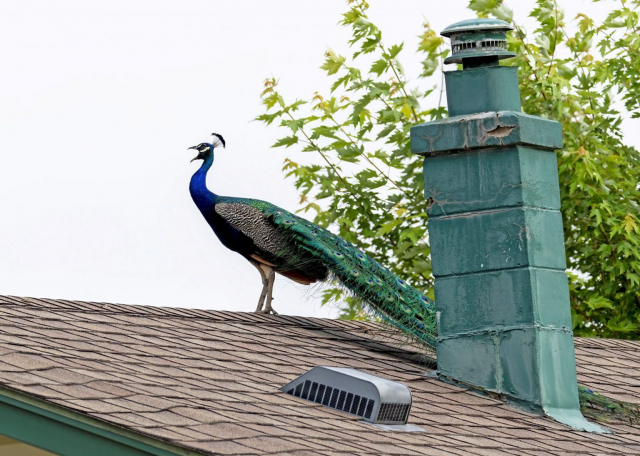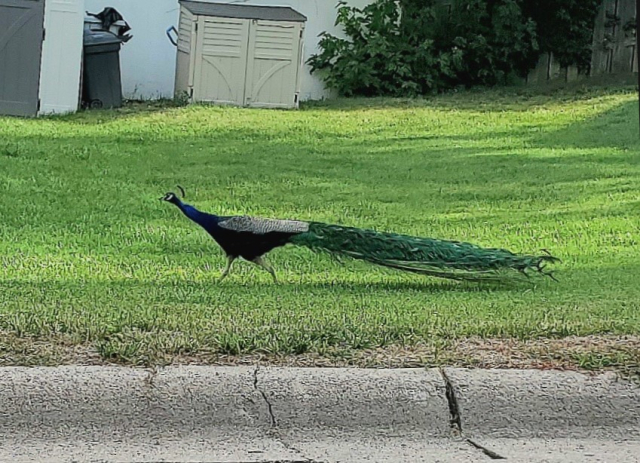PAVO CRISTATUS
Status: No accepted records.
Taxonomy: No subspecies are recognized (AviList 2025).
Comments: Free roaming, escaped, or released birds are occasionally observed in Nebraska, although there are, however, three flocks that have survived for several years in the state. An intriguing explanation for the presence (Eileen Rooney fide Mary Clausen) of two of the three known populations is that at two of the locations, Grand Island and South Omaha, it has been suggested the birds are descended from releases or escapes from racetracks- Aksarben in Omaha and Fonner Park in Grand Island.
A flock has persisted at Cody Park, Lincoln Co since the 1970s (John Carlini, personal communication); 19 were counted, including some white individuals, in 2014 (Amy Taft, Cody Park – 7 species (ebird.org). This Cody Park flock is maintained within a fenced area but is free-flying and often seen in neighborhoods near Cody Park (Boni Edwards, personal communication); 23 were counted in a tree in a residential area near Cody Park 19 Feb 2023 (Coen Kliewer, (19 Feb 2023 – North Platte, NE).
A flock of around 14 birds present since 2016 appears to be surviving and increasing in a neighborhood near 51st and L Streets in South Omaha, Douglas Co (Bella Caracta, WOWT TV, 2023; Mary Clausen, personal communication). One was present 22 May 2024. Bellevue Berry Farm, Sarpy Co, hosts a small population, reported from Jun-Oct 2024 and 17 May 2025.
The third group is in Grand Island, Hall Co in an area between Geddes and Eldorado streets, and as of 2022 consisted of “at least 60” birds whose “nests are everywhere” and whose provenance is unknown (At least 60 peacocks are calling Grand Island their home, citizens want them removed | KHGI (nebraska.tv).
Additional reports are of one along County Road B near the Elkhorn River in Dodge Co 5 Aug 2009, four at a farmstead in Pawnee Co 7 Apr 2013, along R Road, Otoe Co 2 Feb 2014, a single bird “walking in a field” in Dawson Co 23 Jun 2017, one near Irvington, Douglas Co 30 Dec 2022, one along Calhoun Road, Douglas Co 4 Apr 2024, one along 902 Road, Keya Paha Co 7 May 2023, one at a farm in Madison Co 10 Mar 2025, and calls near Crystal Cove Park, Dakota Co 18 May 2025. Documented reports of likely captives away from known locations in 2025 were of two in western Douglas Co 21 Jun and one at Crescent Lake NWR 13 Jun.
eBird classifies reports of Indian Peafowl as either “Exotic: escape” or “Domestic type”. The latter are birds kept with other confined birds such as domestic chickens and/or ducks and are not free roaming. Such reports include birds kept in zoos (Lincoln and Scottsbluff) and a report of one with chickens in a private yard.
There are established feral populations in southern California and Hawaii, and notable populations in Florida (Kannan and James 2020), many of which are considered feral (eBird.org). In addition, there are numerous small groups scattered across the US (eBird.org); many of these are associated with a single homeowner or ranch (Kannan and James 2020).
Images
Literature Cited
AviList Core Team, 2025. AviList: The Global Avian Checklist, v2025. https://doi.org/10.2173/avilist.v2025.
Kannan, R. and D.A. James. 2020. Indian Peafowl (Pavo cristatus), version 1.0. In Birds of the World (S. M. Billerman, Editor). Cornell Lab of Ornithology, Ithaca, NY, USA. https://doi.org/10.2173/bow.compea.01.
Recommended Citation
Silcock, W.R., and J.G. Jorgensen. 2025. Indian Peafowl (Pavo cristatus). In Birds of Nebraska — Online. www.BirdsofNebraska.org

Birds of Nebraska – Online
Created 20 Aug 2025


